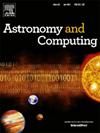Data based investigation on galaxy formation and evolution theory through statistical techniques
IF 1.8
4区 物理与天体物理
Q2 ASTRONOMY & ASTROPHYSICS
引用次数: 0
Abstract
The present work deals with a large data set of star-forming as well as quiescent galaxies at red shifts ranging from 0 to 4 (0z4). The present selected catalogues of objects have been compiled from the NEWFIRM Medium-Band Survey (NMBS). We have concatenated both the catalogues AEGIS and COSMOS, present in NMBS, one after another to form a master catalog. Several derivable parameters were present in the catalog, but we have limited our choice to the observable as well as the physical parameters of the galaxies. In this paper, we have studied the evolutionary pattern of the galaxies by dividing them into various groups according to red shift, and observing the distributional pattern of those groups. Later, the evolutionary pattern of the galaxies is investigated by examining the size-mass relationship corresponding to these groups and comparing the level of dependence of the parameters under study.
In order to perform a proper analysis of the data for the above-mentioned objectives, we have used statistical techniques like multiple testing, the Shapiro–Wilk test, independent component analysis, multivariate outlier detection, multivariate kernel density estimation, and kernel regularized least squares method. Two noble findings that have been observed in this work are (a) The galaxy parameters with high red shifts (z 3.5) follow a multivariate Gaussian distribution, helping us to infer that high red shift (z 3.5) galaxy parameters show more randomness compared to other galaxies with z3.5. (b) There is a deviation from the linearity of the covariates in very high-redshift galaxies (z 3.5) for modeling log mass as a response variable. The same is also observed with the half-life radius as the response variable, although there exists a linear relationship between the mass and the effective radius of the galaxy. These observations may be treated as new findings of the present study.
基于数据的星系形成与演化理论统计研究
目前的工作处理了一个大的恒星形成数据集,以及在红移范围从0到4(0≤z≤4)的静止星系。目前选定的天体目录是根据NEWFIRM中等波段调查(NMBS)编制的。我们将NMBS中存在的AEGIS和COSMOS两个星表依次连接起来,形成一个主星表。星表中有几个可衍生的参数,但我们的选择仅限于可观测的以及星系的物理参数。在本文中,我们研究了星系的演化模式,根据红移将它们分成不同的群,并观察了这些群的分布模式。随后,通过检查这些星系群对应的大小质量关系和比较所研究参数的依赖程度来研究星系的演化模式。为了对上述目标的数据进行适当的分析,我们使用了多元检验、Shapiro-Wilk检验、独立成分分析、多元离群值检测、多元核密度估计和核正则化最小二乘法等统计技术。在这项工作中观测到的两个重要发现是:(a)具有高红移的星系参数(z >;3.5)服从多元高斯分布,帮助我们推断高红移(z >;3.5)与z<;3.5的其他星系相比,星系参数表现出更大的随机性。(b)在非常高红移星系(z >;3.5)将对数质量建模为响应变量。虽然星系的质量和有效半径之间存在线性关系,但以半衰期半径作为响应变量也观察到同样的结果。这些观察结果可视为本研究的新发现。
本文章由计算机程序翻译,如有差异,请以英文原文为准。
求助全文
约1分钟内获得全文
求助全文
来源期刊

Astronomy and Computing
ASTRONOMY & ASTROPHYSICSCOMPUTER SCIENCE,-COMPUTER SCIENCE, INTERDISCIPLINARY APPLICATIONS
CiteScore
4.10
自引率
8.00%
发文量
67
期刊介绍:
Astronomy and Computing is a peer-reviewed journal that focuses on the broad area between astronomy, computer science and information technology. The journal aims to publish the work of scientists and (software) engineers in all aspects of astronomical computing, including the collection, analysis, reduction, visualisation, preservation and dissemination of data, and the development of astronomical software and simulations. The journal covers applications for academic computer science techniques to astronomy, as well as novel applications of information technologies within astronomy.
 求助内容:
求助内容: 应助结果提醒方式:
应助结果提醒方式:


